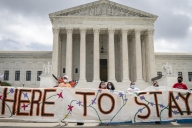You have /5 articles left.
Sign up for a free account or log in.

Photo illustration by Justin Morrison/Inside Higher Ed | Davizro/iStock/Getty Images | Library of Congress
American academia stands at a crossroads. Wherever we turn, universities, their faculty and administrators are being assaulted for actions taken and not. For thinking the “wrong” thoughts, for teaching “dangerous” ideas to our students, for supporting admission of diverse student bodies, for hiring faculty and staff who reflect our population, and for not supporting institutional stands that would at best be purely performative in nature.
I’ve been mulling over this reality for a number of years from the perspectives of both a faculty member at a public flagship university and a leader of a large professional organization. Sadly, these pressures have now fermented and reached explosive and increasingly destructive proportions.
Up until recently, I had feared the radical right posed the most dangerous threat to the core of academic life, innovation and creativity. Certainly the record of affronts to academic freedom and unfettered creativity in Florida, Texas and some other U.S. states has been stunning, scary and framed with half-truths and fear-mongering. Almost every day we hear of another affront to academic freedom, as the right has been relentless in pushing legislation targeting classroom speech, diversity, equity and inclusion programs, and faculty tenure.
More recently, however, the threat from the left has become just as acute, intolerant and stifling as the threats emanating from the right-wing MAGA political pack (even if such terms as “left” and “right” are problematic). The difference, of course, is that the left clothes their attacks on academic freedom in their view of justice and some self-defined, righteous moral code.
Granted, the right exists within a space of institutionalized power, while most of the left has less such power. But whether we focus on the illiberal left or the MAGA right, both sides seek to suppress intellectual dialogue. They exclude and silence those with whom they disagree, shout down dissent and provide little space for dialogue that might actually seek to develop solutions to the vexing problems facing our society and world. The MAGA dominance of the Republican Party in the U.S. Congress has produced by many indexes one of the least productive legislatures in U.S. history. Elected representatives squander their time on empty investigations of political foes instead of seeking dialogue and compromise in the spirit of solving the many serious problems we face.
Similarly on the left, dialogue frequently takes a back seat to performative virtue signaling. This can be seen in the academic left’s efforts to condemn Israel’s war in Gaza by pushing academic institutions to denounce Israel’s prosecution of the war and the tandem destruction of Hamas, along with more than 40,000 Palestinians along the way.
While their cause may be righteous, their efforts tend to be highly performative and brush aside any practical limits on what academic institutions can achieve through the adoption of frameworks like boycott, divestment and sanctions as a means of pressuring Israel to change course. They generally ignore the impacts of their efforts on Jewish students and faculty at those institutions and the reality that their tactics often silence dissent, suppress academic dialogue and learning, and create widespread insecurity inside the spaces where many of us have made our lifelong intellectual homes.
Ironically, the assault from the left produces the same antidiversity sentiments that are at the core of the MAGA assaults on academia. If you aren’t entirely—and I do mean entirely—with the left, you are vilified; Jews, Israelis and other (perhaps tepid) supporters of Israel are cast aside as corrupt even when their perspectives might provide some balance to the polarized rhetoric that dominates the public debates today.
Moreover, the tactics used by many of the self-ordained justice warriors on the left are little different than those employed by the MAGA crowd that the left so abhors. As someone who recently retired from leadership of a major social science professional association, I have experienced attempted bullying and intimidation from all directions. For instance, for not supporting BDS for our association (even though I am sympathetic personally), I and others in leadership have been accused of solidifying the association’s “complicity in genocide.”
Put simply, the left wants capitulation to their point of view, and any practical implications for an intellectually and demographically diverse association be damned.
Frankly, the tactics of the BDS-supporting left are strikingly similar to those used by the likes of Representative Elise Stefanik in her attacks on university presidents in recent months. There is little nuance or interest in understanding the role and place of academic institutions and no space for serious discussion about the issues at hand. And there is no acknowledgment that the strength of the academy is in our ability to maintain dialogue and problem-solving even when that dialogue is uncomfortable. Sadly, the only real products emerging from today’s tactics of the right and the left are anger, fear, sadness and insecurity.
Also puzzling is the singular focus of the left on Gaza, raising the question of why not similar outrage about other atrocities around the globe? Ignoring atrocities ranging from the Russian invasion of Ukraine and the mass imprisonment of Uyghurs in China to the civil war in Sudan only further raises suspicions that the BDS movement is indeed rooted in anti-Semitism. Otherwise, why isn’t the left protesting every other atrocity in the same way?
Returning to the title theme of this essay, where do these attacks leave the academy today?
I believe firmly that we are at a tipping point where the academy that has long fostered innovation, creativity and an openness to alternative viewpoints may well crumble because of intolerance and authoritarian pressures from both left and right. Sadly, I also fear that the mostly centrist and well-meaning majority may stay silent in the face of these attacks. Some of that silence is the reflection of all the daily pressures of getting the job done and keeping the lights on. But that silence is dangerous: We stay silent hoping that a problem will go away, while bits and pieces of a healthy, rich and vibrant academy are chipped away until we no longer recognize it as the American academy.
Much of my pessimism is rooted in my experience with those on the BDS left who have been completely unwilling to seek compromise and respond only by shouting down even reasoned and polite disagreement. They have even been unwilling, in my experience, to accept continuing dialogue on difficult topics. If you can’t even support creative and ongoing dialogue, what steps forward do we have toward finding any common ground and supporting intellectual community? Isn’t that what academic associations and universities are supposed to do? In essence, we become what the right wants us to be: “educators” teaching a single view—their own.
In the end, I believe that the future of the academy will depend on the silent center speaking up and taking risky stands against both the negative forces of the left and the right. From the right, we see blatant attacks on tenure and academic freedom emerging from the statehouses. From the left, in an ironic twist, academic freedom is also at stake as they seek to compel everyone to virtue-signal their own moral and ethical superiority. And with further irony, the champions of (their own version of) diversity, equity and inclusion will do everything they can to exclude and denounce those who don’t pass their self-designed litmus test. As one Japanese colleague said to me recently, they all have “no ears to hear.”








